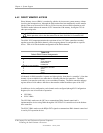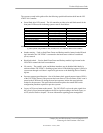
Chapter 4 System Support
BIOS function (refer to Chapter 8 for BIOS function descriptions).
4.7
his section describes functions having to do with security, power management, temperature, and
overall status. These functions are handled by hardware and firmware (BIOS) and generally
nf .
4.7.1
this
etup) and
does not describe security features that may be provided by the operating system and application
software.
4.7.1.1 Power-On Password
(cleared) through
jumper on the system board. The jumper controls a GPIO input to the 82801 ICH2 that is
hecked during POST. The password is stored in configuration memory (CMOS) and if enabled
er will require that either the password be cleared (preferable solution
nd described below) or the entire CMOS be cleared (refer to section 4.6).
4.7.1.2 Setup Password
he Setup utility may be configured to be always changeable or changeable only by entering a
SYSTEM MANAGEMENT
T
co igured through the Setup utility
SECURITY FUNCTIONS
These systems include various features that provide different levels of security. Note that
subsection describes only the hardware functionality (including that supported by S
These systems include a power-on password, which may be enabled or disabled
a
c
and then forgotten by the us
a
To clear the password, use the following procedure:
1. Turn off the system and disconnect the AC power cord from the outlet and/or system unit.
2. Remove the cover (hood) as described in the appropriate User Guide or Maintainance And
Service Guide. Insure that all system board LEDs are off (not illuminated).
3. Locate the password clear jumper (header is labeled E49 on these systems) and move the
jumper from pins 1 and 2 and place on (just) pin 2 (for safekeeping).
4. Replace the cover.
5. Re-connect the AC power cord to the AC outlet and/or system unit.
6. Turn on the system. The POST routine will clear and disable the password.
7. To re-enable the password feature, repeat steps 1-6, replacing the jumper on pins 1 and 2 of
header E49.
T
password. The password is held on CMOS and, if forgotten, will require that CMOS be cleared
(refer to section 4.6).
Compaq Evo and Workstation Personal Computers
Featuring the Intel Pentium 4 Processor
Second Edition – January 2003
4-26


















